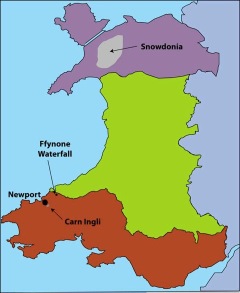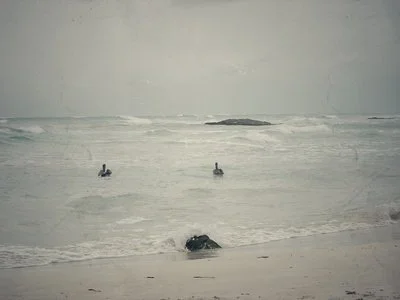In Wales, Nothing is Quite What it Seems
by Elyn Aviva
We were savoring our after-dinner espressos at Llys Meddyg, a “restaurant with rooms,” in Newport, Pembrokeshire, Wales, when my cell phone rang. I looked at it suspiciously.
During the week we had stayed at Llys Meddyg the cell phone had never functioned inside the hotel. There simply wasn’t any signal. To make a phone call, I had to walk down the street waving it in the air until gradually the bars started showing up.
The phone kept ringing. I answered it and heard a woman’s voice, speaking rapidly. “Hi, this is Winifred. I hear you’re going to write about my land. If you write about my land, you’d better get it right!”
“Hello,” I replied. “How’d you hear about us?”
“My friend David told me. When can we meet?”
The phone suddenly cut out. I ran outside the restaurant and down the street, looking for a signal. One bar, two bars, three. I tried to return the call. It rang once and Winifred answered.
“Sorry, we lost the connection.” I said.
“It’s because of all the volcanic rock in the Preselis. It interferes with cell phone transmissions.”
“So that’s why!” I exclaimed. “I wondered.”
“When can we meet?” she repeated.
“We’re leaving Newport tomorrow.”
“I’ll be there in half an hour. Meet you at Parrog beach at 8:30.”
“We’ll be there.”
Gary and I finished our espressos, discussed the improbability of receiving a cell phone call in the “hotel dead zone,” and strolled down to the beach to await the mystery caller. Soon she arrived. Or, more accurately, she descended on us like a force of nature, her words tumbling out as fast as a torrential waterfall. Dark-haired, slim, intense, she gestured expressively as we walked along the beach.
“David told me you are writing a book about my land.”
We nodded. We were doing research for our Powerful Places in Wales guidebook.
“How much do you know? I mean, really know about this place?”
I said, “Probably not much.”
Gary added, “Certainly not enough.”
Winifred pointed to the undulating Carn Ingli peak. “For example, do you know what that is?”
“Carn Ingli,” Gary replied.
“What it really is? Do you know that the figure of a sleeping goddess is silhouetted on the top? And that the Preseli Mountains were used as an astronomical observatory? The south has to do with the moon, and the north with the sun. Did you know there are seven underground energy streams that run through the mountains?”
Gary and I looked at each other. “Can’t say we knew all that,” I responded.
“And did you know that Gors Fawr Stone Circle is a complex astronomical machine? In fact, the entire Preselis are a huge observatory for calculating equinoxes, solstices, and eclipses. After millennia, ancient people’s math skills improved and they were able to condense what previously it had taken a mountain to measure. They compressed their observations into one monument: Stonehenge.”
Testing her, I said, “I’d heard claims that Merlin brought Stonehenge from Ireland.”
“There were Irish tribes settled in this area, so it’s no surprise that people said the Stonehenge bluestones came from Ireland. They didn’t mean the island of Ireland, they meant from here.” She gestured with a sweep of her hands to the Preselis, the origin of the bluestones that had somehow been transported (by Merlin, men, or glaciers) 140 miles east and incorporated into Stonehenge.
While she paused for breath, Gary and I told her about our visit to a nearby chapel in the hills, and how Gary had dowsed for energy lines. She nodded.
“Farmers come to me and ask me to find underground water.”
I asked, “Do you use dowsing rods?”
“No, I don’t need those wiggly things. I just take off my shoes and walk the land.”
As we headed to a nearby bar, Winifred told us some of her history. She was an “indigenous” Welshwoman, descended from a long line of Welsh people who had lived near Newport for generations. She responded to the land in her soul—as well as through the soles of her feet.
Winifred paused for breath. She apologized, explaining she wasn’t feeling well. She’d been out of the country—over the border to England—for a few days. “It was difficult,” she said. “It affected me badly, not being able to know what the weather will be like by looking at the sky and the mountains. Not speaking my own language.” She sighed. “It’s good to be back home.”
I marveled at her rootedness in the terrain. My grandparents and my father were immigrants, and I have moved a great deal—including moving to Spain three years ago. What would it be like to be so connected to a locale, to “feel” it in your bones? I had no idea.
Winifred wasn’t the only person we met with a strong connection to the land. Another was our friend Jane, Welsh “by adoption.” She had moved to Wales some 25 years ago, learned the language, and immersed herself in Welsh legends and landscape.
Jane took us on a tour of Wales, regaling us with stories from the Mabinogi, the medieval Welsh story collection first published in translation by Lady Charlotte Guest in 1849.
In Snowdonia National Park, she pointed out where the magician Gwydion had chased Blodeuwedd “the Flower Woman” and her ladies to Llyn Morynion (the Lake of the Maidens), located in the hills near Ffestiniog. “Here is where the ladies drowned and Blodeuwedd was transformed into an owl.”
“But isn’t that just a story?” I asked, a bit bemused.
“It is and it isn’t,” Jane explained. “There are archetypal energies at work. The stories describe the shift from matriarchy to patriarchy, and from goddess-power to male dominance. They map these events on the land.”
“I see,” I said, although I wasn’t sure I did.
Later, as we strolled down a forest trail to Ffynone Waterfall (also known as Cwm Cuch Waterfall) Jane said, “This is the place described in the Mabinogi where Lord Pwyll met the Lord of the Underworld.”
“But isn’t that just a story?” I naively asked again.
“Well, it is and it isn’t.” She hesitated, then continued. “Actually, there’s some debate if this is the actual place. It might have been another waterfall nearby. There’s a woman who claims the encounter took place at the waterfall near her house, and she has convinced enough people that buses of tourists come to see it. I don’t agree, however.”
I looked at the dense bracken undergrowth, the moss-shrouded trees. Could this have been the place where a Welsh prince encountered an underworld king? I shivered. But then I shook myself out of my self-imposed trance: after all, we were talking about legends, not reality. Weren’t we?
Jane continued. “There’s also a heated argument about the true location of Pwyll’s castle. Some say his castle was in Narberth, southeast of here, but most believe that this was Pwyll’s favorite hunting ground. So perhaps his castle was near here.”
“But wasn’t Pwyll just a character in a medieval epic?”
“It’s not that simple. There may have been a historical person who became part of the legend. Or maybe an archetypal energy melded with a historic person. Like the story of King Arthur. Where does history start and myth end? Or vice versa?”
Suddenly I heard a noise in the forest. I turned to look. Was a leaf-shrouded face peering at me from inside a hollow trunk? Was something unseen making the fern fronds tremble? After all, I was in Wales, a land where nothing is quite what it seems and reality is seen through a looking glass.
Elyn Aviva is a writer, fiber artist, and transformational traveler. Currently living in Girona (Catalonia), Spain, she is fascinated by pilgrimage and sacred sites. Her PhD in anthropology was on the modern Camino de Santiago in Spain. Aviva is author of a number of books on pilgrimage and journey, and she is co-author with her husband, Gary White, of “Powerful Places Guidebooks. ” The most recent one is Powerful Places in Ireland; Powerful Places in Wales is forthcoming. To learn more about Elyn or her publications, go to www.pilgrimsprocess.com and www.powerfulplaces.com and www.fiberalchemy.com







